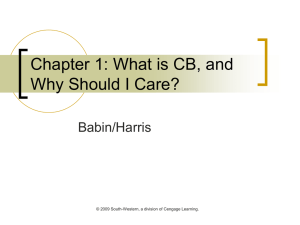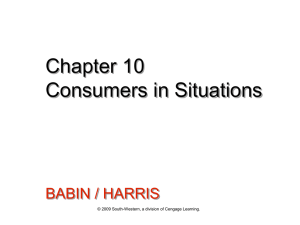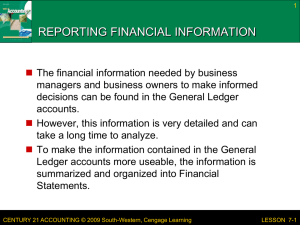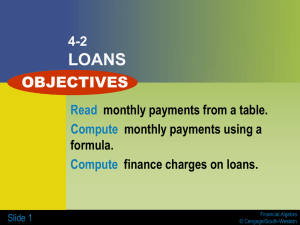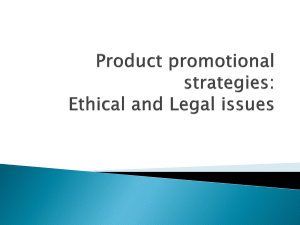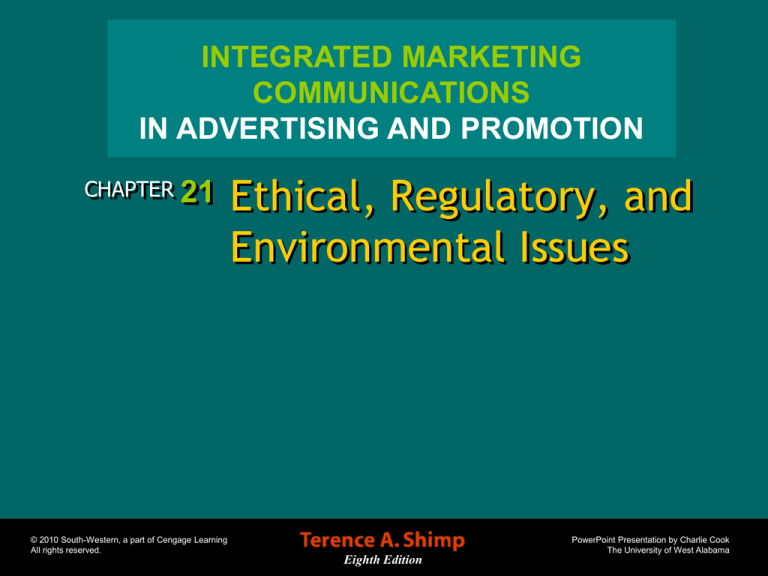
INTEGRATED MARKETING
COMMUNICATIONS
IN ADVERTISING AND PROMOTION
CHAPTER 21
Ethical, Regulatory, and
Environmental Issues
© 2010 South-Western, a part of Cengage Learning
All rights reserved.
PowerPoint Presentation by Charlie Cook
The University of West Alabama
Eighth Edition
Chapter Objectives
After reading this chapter you should be able to:
1. Appreciate the ethical issues associated with
advertising, sales promotions, and other marcom
practices.
2. Understand why the targeting of marketing
communications toward vulnerable groups is a
heatedly debated practice.
3. Explain the role and importance of governmental
efforts to regulate marketing communications.
4. Be familiar with deceptive advertising and the
elements that guide the determination of whether a
particular advertisement is deceptive.
© 2010 South-Western, a part of Cengage Learning. All rights reserved.
21–2
Chapter Objectives (cont’d)
After reading this chapter you should be able to:
5. Be acquainted with the regulation of unfair business
practices and the major areas where the unfairness
doctrine is applied.
6. Know the process of advertising self-regulation.
7. Appreciate the role of marketing communications in
environmental (green) marketing.
8. Recognize the principles that apply to all green
marcom efforts.
© 2010 South-Western, a part of Cengage Learning. All rights reserved.
21–3
Ethical Issues in Marketing Communications
• Ethics in Marcom
Involves matters of right and wrong, or moral, conduct
pertaining to any aspect of marketing communications
Honesty, honor, virtue, integrity
• Ethical Conduct
Lack of consensus about what it is
Ethical lapses and moral indiscretions occur under
pressures of trying to meet business goals and
attempting to satisfy the demands of the financial
community
© 2010 South-Western, a part of Cengage Learning. All rights reserved.
21–4
Sources of Ethical Issues
Targeting Marcom
Public Relations
Advertising
Ethical Issues in
Marketing Activities and
Communications
Packaging
Communications
Sales Promotions
Internet Marketing
© 2010 South-Western, a part of Cengage Learning. All rights reserved.
21–5
The Ethics of Targeting
• Ethical Debate
Is it ethical to target products
and communications efforts to
segments that vulnerable or
put at risk by these actions?
• Is Targeting Unethical or
Just Good Marketing?
When does a good targeting
strategy become a method of
unfair (unethical) advantage?
© 2010 South-Western, a part of Cengage Learning. All rights reserved.
21–6
Is Targeting Unethical or
Just Good Marketing?
• Positive
Targeting benefits
rather than harms
consumers—providing
them with products
best suited to their
particular needs and
wants
© 2010 South-Western, a part of Cengage Learning. All rights reserved.
• Negative
Targeting is not
concerned with fulfilling
consumers’ needs and
wants, but rather with
exploiting consumer
vulnerabilities
21–7
The Ethics of Targeting
Ethical Issues in
Targeting Children
and Teens
Targeting Food and
Beverage Products
Targeting Tobacco and
Alcohol Products
© 2010 South-Western, a part of Cengage Learning. All rights reserved.
Targeting Miscellaneous
Products
21–8
Targeting to Children and Teens
• Negative Targeting Outcomes
Products targeted to kids are unnecessary and the
communications involved are exploitative
Posters, book covers, free magazines, advertising, and other
so-called learning tools that are ads for products
Movies with tie-in merchandise programs
Targeting adult products (e.g., beer) to pre-adults
Using unacceptable cartoon-like images (e.g., Joe Camel)
Promoting adult-oriented entertainment (e.g., violent films,
video games, and music products) to children and teens
Marketing food products (e.g., high-fat, high-calorie snacks)
that contribute to childhood obesity
© 2010 South-Western, a part of Cengage Learning. All rights reserved.
21–9
Targeting to Economically Disadvantaged
Consumers
• Billboards advertising tobacco and alcohol
disproportionately appear in inner-city areas
• Examples:
R.J. Reynolds attempt to market new brands
cigarettes to African-Americans and downscale young
women
Heileman Brewing Company’s targeting of “Power
Master” high-alcohol malt liquor to inner-city
neighborhoods
© 2010 South-Western, a part of Cengage Learning. All rights reserved.
21–10
Figure 21.1
Targeting
Tobacco
Products
© 2010 South-Western, a part of Cengage Learning. All rights reserved.
21–11
Ethical Issues in Advertising
Advertising Creates and
Perpetuates Stereotypes
Advertising Is Untruthful
and Deceptive
Advertising Is
Manipulative
Criticisms of
Advertising
Advertising Is Offensive
and in Bad Taste
© 2010 South-Western, a part of Cengage Learning. All rights reserved.
Advertising Persuades
People to Buy Things
They Do Not Need
Advertising Plays on
People’s Fears and
Insecurities
21–12
American Association of Advertising
Agencies’ Code of Ethical Standards
• Ethical Code and
Standards of Practice
Set lofty goals for the
advertising industry and
provides a framework for
evaluating whether or not
ads meet the high
standards specified
© 2010 South-Western, a part of Cengage Learning. All rights reserved.
21–13
Ethical Issues in Public Relations
• Publicity
Involves disseminating positive information about a
firm and its products and handling negative publicity
Like advertising—the same ethical issues apply
• Negative Publicity
When firms confess to product shortcomings and
acknowledge problems or, instead, attempt to cover
up the problems
© 2010 South-Western, a part of Cengage Learning. All rights reserved.
21–14
Ethical Issues in Packaging and Branding
Label Information
Packaging Graphics
Packaging and
Branding
Ethical Issues
Packaging Safety
Environmental
Implications
Brand Naming and
Brand Name Theft
© 2010 South-Western, a part of Cengage Learning. All rights reserved.
21–15
Ethical Issues in Sales Promotions
• Sales Promotions
Manufacturer promotions directed at wholesalers and
retailers and to consumers
• Slotting Allowances
Manufacturers have to pay retailers to handle a new
product—Is this a form of bribery and is it unethical?
• Consumer-Oriented Sales Promotions
A promoter offers a reward for a consumer’s behavior
that not delivered or lies about the odds of winning
Consumers who make false claims for coupon
redemptions and refunds
© 2010 South-Western, a part of Cengage Learning. All rights reserved.
21–16
Ethical Issues in Online Marketing
• Consumer Privacy Issues
Consumer’s privacy rights to personal information and
shopping behaviors collected by online marketers
Security of personal information collected online
Selling of personal information to other parties without
consent of consumer
Bogus positive product evaluations and blogs
deceptively extolling products
© 2010 South-Western, a part of Cengage Learning. All rights reserved.
21–17
Fostering Ethical Marketing Communications
The Golden Rule
Act in a way that you would want others to act
toward you
The Professional Take only actions that would be viewed as proper by
Ethics Test
an objective panel of your professional colleagues
The TV test
Would l feel comfortable explaining this action on
television to the general public?”
© 2010 South-Western, a part of Cengage Learning. All rights reserved.
21–18
Regulation of Marketing Communications
• Justifications for Regulation
When consumer decisions are based on false or limited
information
When benefits realized exceed the costs
• Benefits of Regulation
Improved consumer choices
Improved product quality
Reduction in prices
• Costs
Regulatory compliance
Enforcement costs
Unintended side effects
© 2010 South-Western, a part of Cengage Learning. All rights reserved.
21–19
Regulation by Federal Agencies
Federal Trade
Commission (FTC)
Regulatory Authority
Deceptive
Advertising
Unfair
Practices
© 2010 South-Western, a part of Cengage Learning. All rights reserved.
Information
Regulation
21–20
Regulation by Federal Agencies (cont’d)
Elements of the FTC’s
Deception Policy
Misleading
Misrepresentation
or Omission
Reasonable
Consumer Test
© 2010 South-Western, a part of Cengage Learning. All rights reserved.
Material
Misrepresentation
21–21
Regulation of Unfair Practices
• Unfair Advertising
Acts or practices that cause or are likely to cause
substantial injury to consumers, which is not
reasonably avoidable by consumers themselves and
not outweighed by countervailing benefits to
consumers or competition (emphasis added)
• FTC’s Criteria for Unfair Business Acts
Act offends public policy established by statutes
Act is immoral, unethical, oppressive, or unscrupulous
Act causes substantial injury to consumers,
competitors, or other businesses
© 2010 South-Western, a part of Cengage Learning. All rights reserved.
21–22
Regulation by Federal Agencies (cont’d)
• FTC’s Corrective Advertising Program
Requires a firm that misleads consumers to use
future advertisements to rectify any deceptive
impressions it has created in consumers’ minds
• Food and Drug Administration (FDA)’s
Regulation of Product Labeling
Responsible for regulating information on the
packages of food and drug products
Requires advertisers to present a balanced
perspective when advertising drugs
© 2010 South-Western, a part of Cengage Learning. All rights reserved.
21–23
Regulation by Federal Agencies (cont’d)
• Drug Advertising
FTC regulates deceptive and unfair
advertising for over-the-counter
(OTC) drugs
FDA regulates advertisements for
prescription drugs in requiring
advertisers to present a balanced
perspective when advertising drugs
© 2010 South-Western, a part of Cengage Learning. All rights reserved.
21–24
Regulation of Marketing Communications
• Regulation by State Agencies
Most, if not all, states have departments of
consumer affairs or consumer protection
• Advertising Self-Regulation
Is undertaken by the advertising community itself
(i.e., advertisers, industry trade associations, and
ad media) rather than by governmental bodies.
© 2010 South-Western, a part of Cengage Learning. All rights reserved.
21–25
Advertising Self-Regulation
• Advertising Clearance Process
1. Advertising agency clearance
2. Approval from the advertiser’s legal department and
perhaps also from an independent law firm
3. Media approval
© 2010 South-Western, a part of Cengage Learning. All rights reserved.
21–26
The National Advertising Review Council
• National Advertising Review Council (NARC)
Responsible for receiving or initiating, evaluating,
investing, analyzing and holding initial negotiations
with an advertiser on complaints or questions from
any source involving truth or accuracy of national
advertising
• NARC Organizational Units
The Children’s Advertising Review Unit (CARU)
National Advertising Review Board (NARB)
Council of Better Business Bureau’s National
Advertising Division (NAD)
© 2010 South-Western, a part of Cengage Learning. All rights reserved.
21–27
Environmental Marketing Communications
• Legitimate Green Marketing
Is a firm’s introduction of environmentally oriented
products and its undertaking of marcom programs to
promote them
Seeks to accomplish two objectives:
Improve environmental quality
Satisfy customers
© 2010 South-Western, a part of Cengage Learning. All rights reserved.
21–28
Green Marketing Initiatives
• Green Marketing Communications
Advertisements that promote green products
Environmentally friendly packaging
Seal-of-approval programs promoting green products
Cause- and event-oriented marcom efforts that
support environmental consciousness
Point-of-purchase display materials that are
environmentally efficacious
Direct marketing programs that reduce resource
usage by developing more efficient solicitations
Outdoor advertising efforts that reduce the usage of
environmentally damaging materials.
© 2010 South-Western, a part of Cengage Learning. All rights reserved.
21–29
Figure 21.2
Green Advertising
Addressing the
Biophysical
Environment
© 2010 South-Western, a part of Cengage Learning. All rights reserved.
21–30
Guidelines for Green Marketing
• FTC’s Green Guides
Qualifications and disclosures should be sufficiently
clear and prominent to prevent deception
Claims should make clear whether they apply to the
product, the package, or a component of either
Claims should not overstate an environmental
attribute or benefit, either expressly or by implication
Comparative claims should be presented in a manner
that makes the basis for the comparison sufficiently
clear to avoid consumer deception
© 2010 South-Western, a part of Cengage Learning. All rights reserved.
21–31
Figure 21.4
Green Advertising
Presenting an Image
of Environmental
Responsibility
© 2010 South-Western, a part of Cengage Learning. All rights reserved.
21–32
Guidelines for Green Marketing
General Recommendations
for Environmental Claims
Make
Specific
Claims
Reflect Current
Disposal
Options
© 2010 South-Western, a part of Cengage Learning. All rights reserved.
Make
Substantive
Claims
Make
Supportable
Claims
21–33
Figure 21.3
Green Advertising
Promoting a Green
Lifestyle
© 2010 South-Western, a part of Cengage Learning. All rights reserved.
21–34


